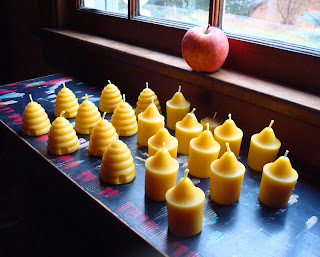After cleaning and filtering the discs of wax from my 'crush and strain' method honey harvest shown in my last post, I ended up with two and a half pounds of pure clean beeswax from my own bees. As a last filtering, I melted the wax in a double boiler and then poured it through a restaurant style grease filter cone, which I set in an empty pineapple juice can (see photo).
I had two flexible silicone candle molds- one to make plain votives with pointed tops, and the other for votive-sized bee skep shaped candles. It was fun to set the wicks, pour the candles with a spouted canning ladle, and then carefully pop them out after cooling for about a half hour. Later, the candle bottoms were pressed onto a hot skillet to get them nice and flat.
Altogether, I was able to make 20 candles from the 2.5 lbs of wax- nine little skeps and 11 tall votives, plus a short 1" votive with the last drips of wax. Next year I will buy another mold or two for added variety.
I had two flexible silicone candle molds- one to make plain votives with pointed tops, and the other for votive-sized bee skep shaped candles. It was fun to set the wicks, pour the candles with a spouted canning ladle, and then carefully pop them out after cooling for about a half hour. Later, the candle bottoms were pressed onto a hot skillet to get them nice and flat.
Altogether, I was able to make 20 candles from the 2.5 lbs of wax- nine little skeps and 11 tall votives, plus a short 1" votive with the last drips of wax. Next year I will buy another mold or two for added variety.
I got my candles done just in time before Christmas...a nice way to end my beekeeping year and bring a warm glow to the dark days to come this winter.
(Click on each picture to see it larger and more detailed.)
(Click on each picture to see it larger and more detailed.)



























